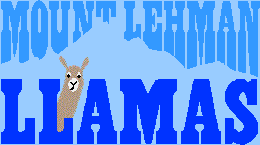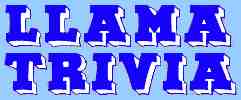
These pages are a collection of odd pictures
and trivia about llamas.
(They are not for sale, they are simply for your entertainment.)
More Llama Stereoviews
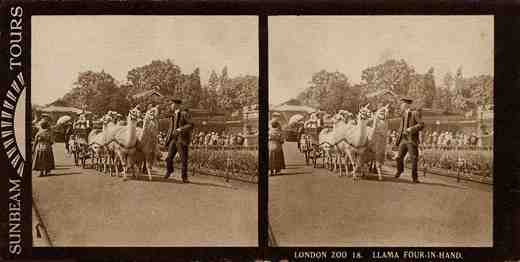
This stereoview card is titled “London Zoo 18 - Llama Four-in-Hand”
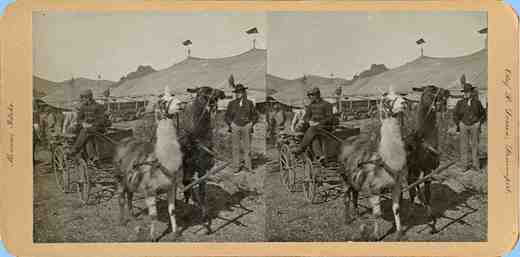
This stereoview card shows a team of llamas hitched to a wagon driven by a circus performer,
with the big top in the background. Circa 1900.
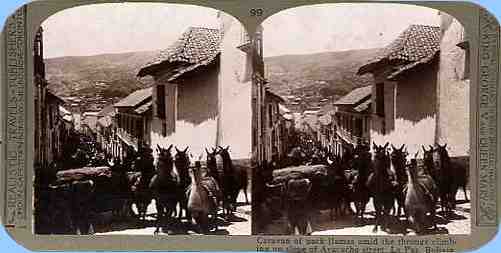
This stereoview card is titled “Caravan of pack llamas amid the throngs
climbing up a slope of Avacucho street. La Paz. Bolivia.”
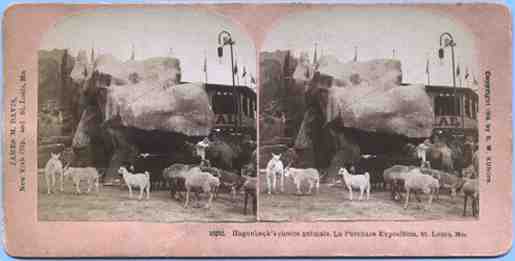
This stereoview from 1904 is titled
“Hagenbeck’s choice Animals. La Purchase Exposition, St. Louis, Mo.”
It shows a llama in with goats, buffalo and camels.
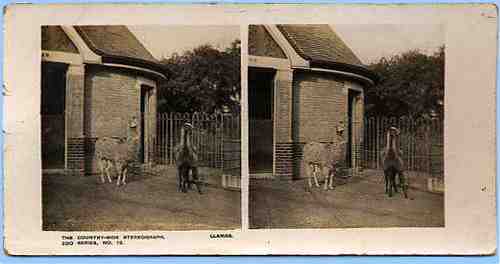
This stereoview card is titled “The Country-side Stereograph.
Zoo Series, No. 12.”
The copy on the reverse is as follows:
LLAMAS (Llama peruana)
The Llamas of Peru (always be careful to spell them with “ll,” because we
do not keep lamas of Tibet, who are a kind of priest, in cages!) are not wild animals.
You might guess this from their varied colouring, which is black or white, reddish or
yellowish, as with most domesticated animals. They are probably descendants of
the guanacos, which are very much like them, and range in herds over the plains of
Patagonia and the crags of Cordilleras. From their habit of always holding their
heads aloft, llamas look much bigger than they are, for they only measure three feet
in height at the shoulders. They look too haughty to be mere beasts of burden, yet
this is their vacation [sic] in Peru, where the male llamas carry about a hundred-weight of
goods a distance of twelve miles a day. In their near relatives, the camels, this
haughty aspect degenerates into an expression of surly contempt; but I regret to say
that the llamas sometimes go beyond this; if you tease them, they will spit copiously
at you with unpleasant accuracy of aim.
E. Kay Robinson,
Editor of the “Country-Side.”

The inscription on this stereoview is
“A busy morning away up among the rugged Andes, Cuzco. Peru.”
It shows locals selling potatoes in the market in front of the Jesuit Church and college.
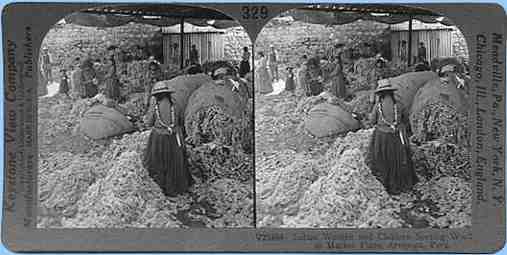
The inscription on this stereoview is
“Indian Women and Children sorting Wool in Market Place, Arequipa, Peru.”
The copy on the reverse is as follows:
INDIAN WOMEN AND CHILDREN
SORTING WOOL, AREQUIPA, PERU
The foothills, high plateaus, mountain valleys, and slopes of Peru are excellent grazing
grazing grounds for llama, alpacas and sheep. There is not enough rainfall for general farming but
the wool-bearing animals find food the year around. The Cholo Indians of the Sierras have
for many years been excellent shepherds. These Indians are naturally expert in caring
for the alpaca, llama, and sheep and the wool they supply.
The men tend the flocks in the hills, while the women sort, clean, spin and weave the wool
into blankets, and other kinds of clothing.
In the larger cities such as Lima, Cuzco, and Arequipa factories for weaving wool into
shawls, bolts of cloth, underwear, and blankets have been established. Their products are
shipped to North America and Europe.
In this view you see Indian women and children sorting wool in one of the warehouses at
Arequipa.
Does the wool in the pile right in front of you look like sheep’s wool? how does it differ
from sheep’s wool? What animal grew this wool? Find another stereograph showing
this wool growing on the animal.

The inscription on this stereoview is
“Making the soft wool of the vicuna into rugs. La Paz, Bolivia.”
Vicuña wool is pretty rare and valuable,
so I would suspect that the rugs are made of llama hides.
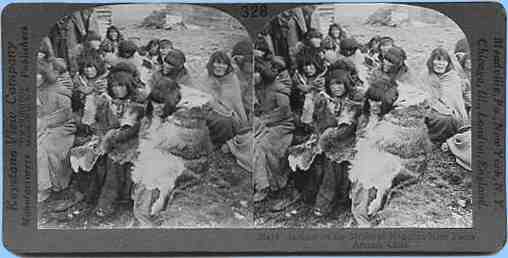
The inscription on this stereoview is
“Indians on the Straits of Magellan near Punta Arenas, Chile.”
It doesn’t say on the card, but I would suspect that the two natives in the front
are wearing blankets made of guanaco skins.
The actual content on the card is not very complimentary to the Indians
so we will omit it here.
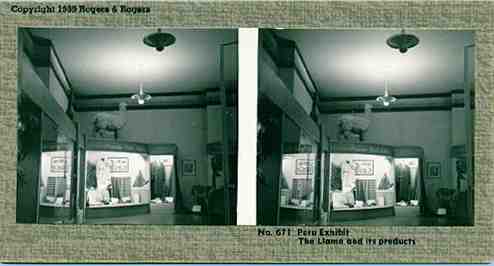
This stereoview is from the 1939 Word’s Fair in New York
and is titled “Peru Exhibit, The Llama and its Products.”
If you don’t have a viewer to see the 3-D stereoviews pictured above,
we have converted them to anaglyph format on a separate page
so that they can be seen by using a set of red/blue anaglyph glasses.

If you don’t have any of these glasses lying around,
you can get a set of free anaylph glasses
by sending a stamped self-addressed envelope to this 3-D supply company.
There are also anaglyph glasses in some issues of magazines
that you might have lying around such as
the August 1998 National Geographic or the winter issue of Sports Illustrated.
We have some colour stereo pictures of some of our llamas as well as
some 3-D pictures taken around the farm plus some stereo llama hiking pictures.
More Llama Trivia Pages:
Visit some of our other web pages:
